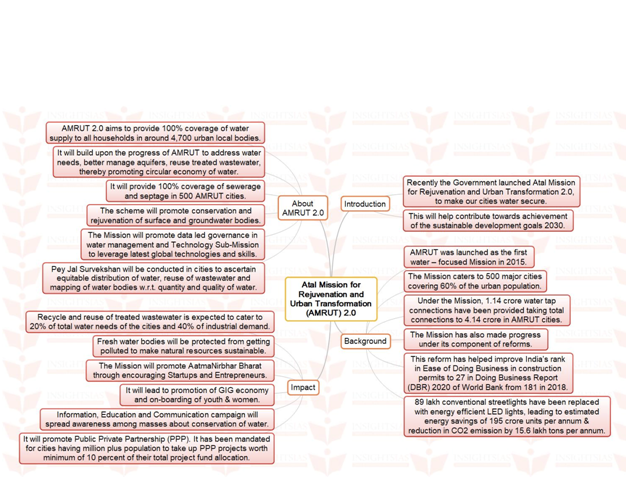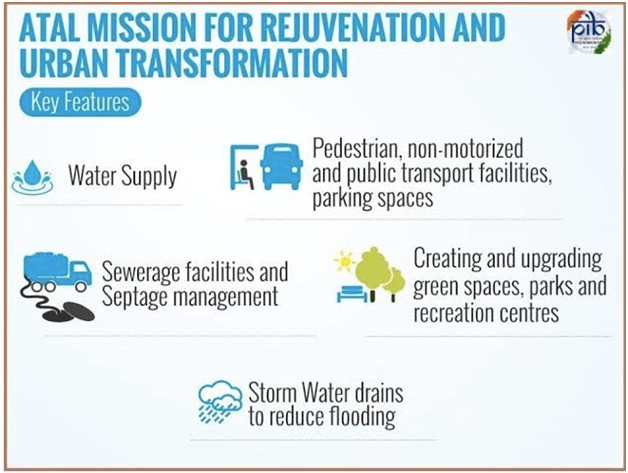AMRUT Scheme
Why in the News?
Recently, AMRUT Mission has been subsumed under AMRUT 2.0, which was launched on 01st October, 2021 and ongoing projects of AMRUT 1.0 will be funded with CA till 31st March, 2023.
- Atal Mission for Rejuvenation and Urban Transformation (AMRUT) 2.0 scheme, which has been launched on 01 October, 2021 for the period of 05 years i.e. from the financial year 2021-22 to the financial year 2025-26, is designed to provide universal coverage of water supply through functional taps to all households in all the statutory towns in the country and coverage of sewerage/septage management in 500 cities covered in first phase of the AMRUT scheme.
AMRUT 2.0:
- AMRUT 2.0 will promote circular economy of water through development of City Water Balance Plan (CWBP) for each city focusing on recycle/reuse of treated sewage, rejuvenation of water bodies and water conservation.
- It will help cities to identify scope for projects focusing on universal coverage of functional water tap connections, water source conservation, rejuvenation of water bodies and wells, recycle/reuse of treated used water, and rainwater harvesting. Based on the projects identified in CWBP, Mission envisages to make cities ‘water secure’ through a circular economy of water.
- Mission also has a reform agenda on ease of living of citizens through reduction of non-revenue water, recycle of treated used water, rejuvenation of water bodies, augmenting double entry accounting system, urban planning, strengthening urban finance etc.
Other components of AMRUT 2.0 are:
- Pey Jal Survekshan to ascertain equitable distribution of water, reuse of wastewater, mapping of water bodies and promote healthy competition among the cities /towns.
- Technology Sub-Mission for water to leverage latest global technologies in the field of water.
- Information, Education and Communication (IEC) campaign to spread awareness among masses about conservation of water.
Key Points
- About:
- It is the continuation of the AMRUT mission launched in June 2015 to ensure that every household has access to a tap with the assured supply of water and a sewerage connection.
- AMRUT 2.0 aims to provide 100% coverage of water supply to all households in around 4,700 ULBs (Urban Local Bodies).
- It also seeks to promote Atmanirbhar Bharat through encouraging Startups and Entrepreneurs (Public Private Partnership).
- Objectives:
- It will build upon the progress of AMRUT to address water needs, rejuvenate water bodies, better manage aquifers, reuse treated wastewater, thereby promoting a circular economy of water.
- It will provide 100% coverage of sewerage and septage in 500 AMRUT cities.
- Recycling and reuse of treated wastewater is expected to cater to 20% of total water needs of the cities and 40% of industrial demand. Under the Mission, fresh water bodies will be protected from getting polluted to make natural resources sustainable.
- Pey Jal Survekshan will be conducted in cities to ascertain equitable distribution of water, reuse of wastewater and mapping of water bodies.
- Performance of AMRUT Phase-I:
- 14 crore water tap connections have been provided taking total connections to 4.14 crore in AMRUT cities.
- Credit rating work has been completed in 470 cities. Of which, 164 cities have received Investable Grade Rating (IGR), including 36 cities with rating of A- or above.
- Rs 3,840 crore has been raised through Municipal Bonds by 10 ULBs. The Online Building Permission System has been implemented in 2,471 cities including 455 AMRUT cities.
- This reform has helped improve India’s rank in Ease of Doing Business in construction permits to 27 in Doing Business Report (DBR) 2020 of World Bank from 181 in 2018.
- 89 lakh conventional streetlights have been replaced with energy efficient LED lights, leading to estimated energy savings of 195 crore units per annum & reduction in CO2 emission by 15.6 lakh tons per annum.





